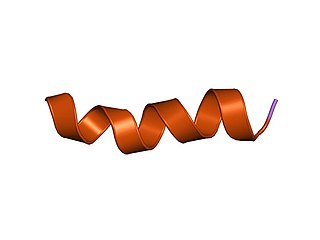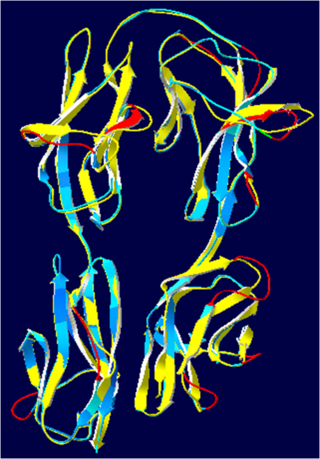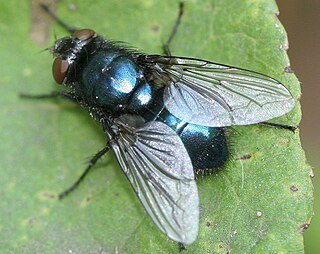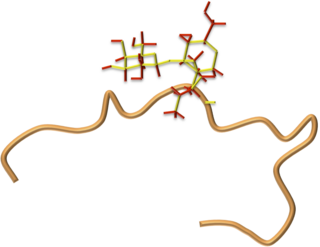
Furin is a protease, a proteolytic enzyme that in humans and other animals is encoded by the FURIN gene. Some proteins are inactive when they are first synthesized, and must have sections removed in order to become active. Furin cleaves these sections and activates the proteins. It was named furin because it was in the upstream region of an oncogene known as FES. The gene was known as FUR and therefore the protein was named furin. Furin is also known as PACE. A member of family S8, furin is a subtilisin-like peptidase.
Cathelicidin antimicrobial peptide (CAMP) is a polypeptide that is primarily stored in the lysosomes of macrophages and polymorphonuclear leukocytes (PMNs); in humans, the CAMP gene encodes the peptide precursor CAP-18, which is processed by proteinase 3-mediated extracellular cleavage into the active form LL-37. LL-37 is the only peptide in the Cathelicidin family found in the human body.
RNAIII is a stable 514 nt regulatory RNA transcribed by the P3 promoter of the Staphylococcus aureus quorum-sensing agr system ). It is the major effector of the agr regulon, which controls the expression of many S. aureus genes encoding exoproteins and cell wall associated proteins plus others encoding regulatory proteins The RNAIII transcript also encodes the 26 amino acid δ-haemolysin peptide (Hld). RNAIII contains many stem loops, most of which match the Shine-Dalgarno sequence involved in translation initiation of the regulated genes. Some of these interactions are inhibitory, others stimulatory; among the former is the regulatory protein Rot. In vitro, RNAIII is expressed post exponentially, inhibiting translation of the surface proteins, notably protein A, while stimulating that of the exoproteins, many of which are tissue-degrading enzymes or cytolysins. Among the latter is the important virulence factor, α-hemolysin (Hla), whose translation RNAIII activates by preventing the formation of an inhibitory foldback loop in the hla mRNA leader.

Procollagen-proline dioxygenase, commonly known as prolyl hydroxylase, is a member of the class of enzymes known as alpha-ketoglutarate-dependent hydroxylases. These enzymes catalyze the incorporation of oxygen into organic substrates through a mechanism that requires alpha-Ketoglutaric acid, Fe2+, and ascorbate. This particular enzyme catalyzes the formation of (2S, 4R)-4-hydroxyproline, a compound that represents the most prevalent post-translational modification in the human proteome.

MAP kinase-activated protein kinase 2 is an enzyme that in humans is encoded by the MAPKAPK2 gene.

T-cell surface glycoprotein CD3 gamma chain is a protein that in humans is encoded by the CD3G gene.

Fungal pheromone mating factor receptors form a distinct family of G-protein-coupled receptors.

Receptor-type tyrosine-protein phosphatase alpha is an enzyme that in humans is encoded by the PTPRA gene.

U1 small nuclear ribonucleoprotein A is a protein that in humans is encoded by the SNRPA gene.

POU domain, class 3, transcription factor 1 is a protein that in humans is encoded by the POU3F1 gene.

Homeobox protein Hox-C5 is a protein that in humans is encoded by the HOXC5 gene.

T-cell surface glycoprotein CD3 delta chain is a protein that in humans is encoded by the CD3D gene.

Cecropins are antimicrobial peptides. They were first isolated from the hemolymph of Hyalophora cecropia, whence the term cecropin was derived. Cecropins lyse bacterial cell membranes; they also inhibit proline uptake and cause leaky membranes.

Hemolin is an immunoglobulin-like protein exclusively found in Lepidoptera. It was first discovered in immune-challenged pupae of Hyalophora cecropia and Manduca sexta.

Drosomycin is an antifungal peptide from Drosophila melanogaster and was the first antifungal peptide isolated from insects. Drosomycin is induced by infection by the Toll signalling pathway, while expression in surface epithelia like the respiratory tract is instead controlled by the immune deficiency pathway (Imd). This means that drosomycin, alongside other antimicrobial peptides (AMPs) such as cecropins, diptericin, drosocin, metchnikowin and attacin, serves as a first line defence upon septic injury. However drosomycin is also expressed constitutively to a lesser extent in different tissues and throughout development.
Hans Gustaf Boman (1924-2008) was a Swedish microbiologist with a special focus on innate immunity. Boman was born on 16 August 1924 in Engelbrekt Parish, Stockholm, Sweden, and died on 3 December 2008. Boman's pioneering research on insect immunity formed the basis for the Nobel Prize in Physiology or Medicine 2011.

Diptericin is a 9 kDa antimicrobial peptide (AMP) of flies first isolated from the blowfly Phormia terranova. It is primarily active against Gram-negative bacteria, disrupting bacterial membrane integrity. The structure of this protein includes a proline-rich domain with similarities to the AMPs drosocin, pyrrhocoricin, and abaecin, and a glycine-rich domain with similarity to attacin. Diptericin is an iconic readout of immune system activity in flies, used ubiquitously in studies of Drosophila immunity. Diptericin is named after the insect order Diptera.

Drosocin is a 19-residue long antimicrobial peptide (AMP) of flies first isolated in the fruit fly Drosophila melanogaster, and later shown to be conserved throughout the genus Drosophila. Drosocin is regulated by the NF-κB Imd signalling pathway in the fly.
HDEL is a target peptide sequence in plants and yeasts located on the C-terminal end of the amino acid structure of a protein. The HDEL sequence prevents a protein from being secreted from the endoplasmic reticulum (ER) and facilitates its return if it is accidentally exported.

Riccardo Cortese was an Italian scientist, entrepreneur, and innovator in the field of gene expression, drug discovery and genetic vaccines. His work led to the development of novel therapeutic strategies for the prevention and cure of viral infections, including HIV, HCV, Ebola and RSV. He pioneered a novel platform technology based on simian adenoviral vectors for prophylactic and therapeutic vaccines, and authored more than 300 publications in peer reviewed journals in the field of gene expression, transcriptional control, molecular virology and immunology.
















